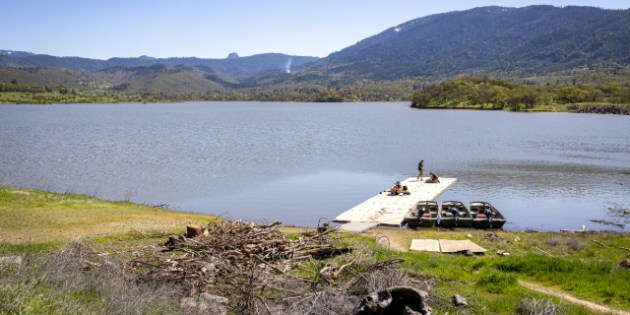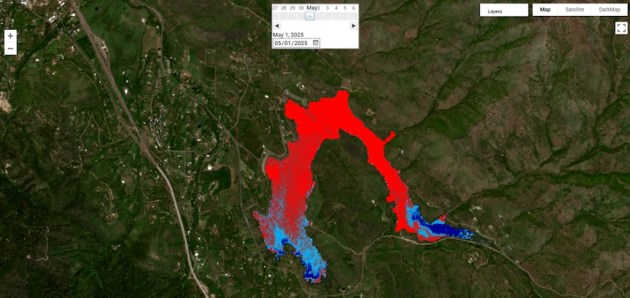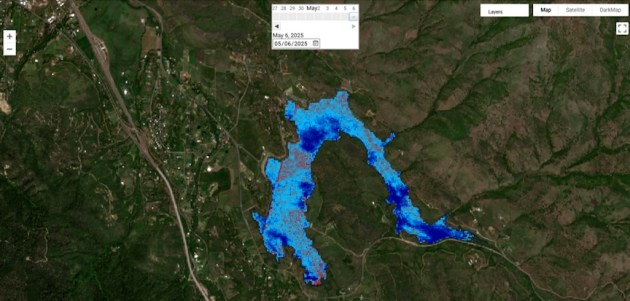Jackson County, TID officials cry foul over Emigrant Lake algae bloom notice
Published 4:09 pm Friday, May 16, 2025
‘False alarm’ led to cancellations and lost revenue for self-supporting park; OHA rep says ‘big lesson’ was learned about ‘advanced notification’
Jackson County and Talent Irrigation District officials say an advisory issued in early May by the Oregon Health Authority regarding potential algae toxins in Emigrant Lake was premature, resulting in lost reservation revenues and unfounded panic in the community about potential impacts to human and animal safety related to the lake water.
The agency had issued a preliminary recreational use advisory on May 1 after a member of the public reported seeing what looked like a cyanotoxin algae bloom in the lake outside Ashland.

United States Geological Survey satellite imagery captured May 1 over Emigrant Lake shows large portions of the lake, highlighted in red, in which a potential cyanobacteria bloom was occurring.
Eight days later, on May 9, OHA officials reported that samples taken from Emigrant Lake tested negative and were considered “below recreational guideline values” for illness-associated toxins common to cyanotoxin blooms.
Jackson County Administrator Danny Jordan said OHA officials should have acknowledged that the agency erred in issuing the advisory and that the agency, in his opinion, should “make changes to its process” for issuing public safety advisories.
“We were compelled to directly confront OHA immediately, as their warning was both reckless and baseless,” Jordan said in a message to the Rogue Valley Times.
“They were slow to correct it. As a result, we’ve faced multiple cancellations — and lost revenue for the parks that are self-supported — and unwarranted public concern, all stemming from a claim with no factual foundation.”
Jackson County Roads and Parks Director Steve Lambert said the advisory resulted in more than $6,000 in camping reservation cancellations and other planned revenues in the eight days between the advisory being issued and then lifted.
Lambert said OHA officials should avoid “creating these preemptive alerts” before they have data.

United States Geological Survey satellite imagery captured May 6 shows areas, highlighted in blue, indicating a lessening of a potential cyanobacteria bloom.
“When people hear of something like a toxic algae bloom, they tend to go to the worst-case scenario and start altering their plans,” Lambert said.
“One of my biggest concerns with this program is that they scare people. … I’ve had this concern for a while. You can go to any water body in Oregon, and you can see little pockets where things gather, whether it’s a lake or a pond. Those small patches are not representative of an entire water body,” he said. “So, you end up with a small surface area of a lake and it could effectively close an entire lake.”
Lambert added, “People get really concerned when they hear of this stuff or see rumors on Facebook and assume it’s going to be worst-case scenarios.”
TID President Mike Winters said irrigation district crews began flushing canals April 28 for the start of the 2025 irrigation season, just days prior to the advisory being made by OHA. Winters said TID employees were bombarded with calls and messages due to the advisory.
“The concern was that there were no tests, no science behind it. We had started to flush the canals and start water for the season. We had people calling who wanted water and we had people who were concerned for their animals and wanted the water shut off … And it was stressful for our employees who were caught in the middle of this,” Winters said.
“While the Talent Irrigation District greatly appreciates the Oregon Health Authority’s commitment to citizen safety, we would appreciate a policy and procedures review of this case in order to help reduce public alarm in the future.”
Winters added, “I understand using satellite imagery to be able to say, ‘Hey, we could have a problem but then send a field unit out to test it, instead of just giving it a 30,000-foot view and putting out an advisory. It felt like a lot of phone calls and a lot of worry, and it ended up being OK.”
OHA officials stood by their decision to post the advisory in order to protect vulnerable community members and pets, but said they would strive for early notification of public entities in the future.

Rogue Rowing’s Kiva Dilansa, front, and Amelie Requejo head out for a light workout at Emigrant Lake in Ashland in June 2024. (Rogue Valley Times file photo)
Gabriela Goldfarb, environmental public health section manager for OHA, said in an interview with the Times that initial photos received indicated a definitive algae bloom but that the bloom had visibly begun to clear by the time sampling was done May 6.
Goldfarb said the advisory was issued “out of concern for vulnerable community members and pets but with the understanding that the lake could still be used.”
When samples were taken, Goldfarb said rowers were contacted by those taking samples who “chatted with them and they talked about how to keep safe.”
Goldfarb said a similar advisory was issued the same week for the Wapato Marsh near the Willamette River, which proved to be warranted.
“I think we definitely have learned one major lesson from this, that we are going to be implementing, which is more advanced notification,” Goldfarb said Friday.
“We will be bringing our county and local public health partners on from the beginning, as soon as something like this is on our radar.”
Goldfarb noted that public concern was likely heightened due to Emigrant Lake being “a regional resource with such a big population nearby and this being the first time in years that it has filled.”
She added, “We had a lot of factors that made this really concerning for a lot of folks in the community.”
Lambert said he was hopeful to see revisions to the advisory system for the sake of the tourism industry both locally and around the state.
“Statewide, there are a lot of businesses that serve our outdoor recreation and tourism industry and they’re affected by these decisions being made. I’m (also) concerned that when you start issuing these false alarms, the public will get fatigued from that and maybe eventually not pay as much notice when they actually should,” he said.
“OHA can say, ‘Well, we’re not closing the lake — we’re just warning people,’ but when the Oregon Health Authority delivers a message like the one they delivered … the general public takes that as, ‘Stay the heck out of the water!’”
Reach reporter Buffy Pollock at 458-488-2029 or buffy.pollock@rv-times.com. Follow her on Twitter @orwritergal.










